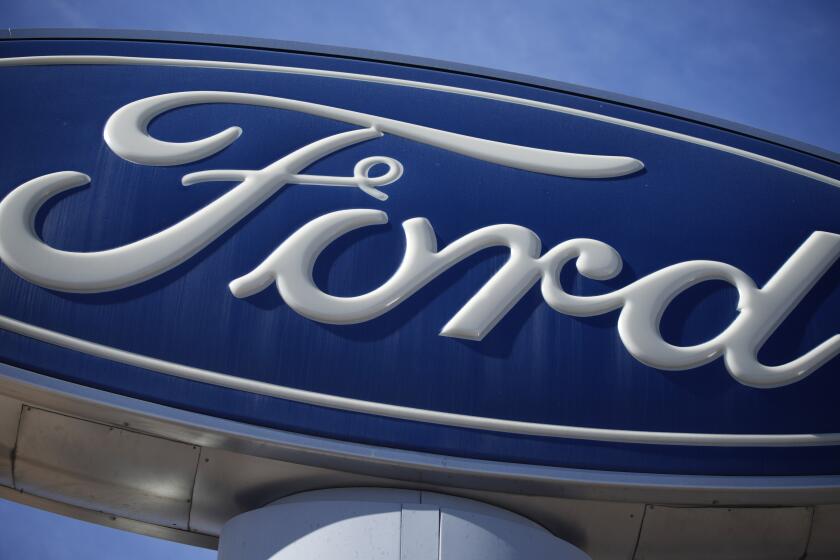More Shopping Malls Going Alfresco
Malls, the bastions of merchandising that for decades relied on fashion and food courts to entice shoppers, are losing their lids -- and not just in sunny Southern California.
Drive by some of the nation’s newest retail attractions and it’s clear that the conventional mall is declining in status.
Developers are tearing down or reconfiguring covered malls from Raleigh, N.C., to Columbus, Ohio, making room for outdoor centers that mix traditional retailers with big-box stores, high-density housing, stadium-style theaters, grocery stores and restaurants.
Malls have made the transition to “alls,” open-air centers in Pasadena, Sherman Oaks and Long Beach. The trend continues in Torrance, Whittier and Huntington Beach, where developers hope to mimic the downtown experience that is missing from many suburban communities.
“Many people live in communities where there’s not a main street where they can walk, window shop and meet people,” said Ellen Greenberg, director of research at the Congress for the New Urbanism, a Chicago-based nonprofit organization that favors pedestrian-friendly neighborhoods with a mix of housing. “What we’re learning is people value that and miss it, which is why it’s being imitated in these lifestyle centers.”
Competition from discount retailers and shopping centers is also contributing to the de-malling trend, according to experts, as is the appeal of the open-air center to exposure-hungry retailers seeking more spacious digs and harried shoppers who don’t want to schlep through an entire mall to make a simple purchase.
“These days, you either go for the experience, like the Grove, or you go to Wal-Mart for the discount,” said urban planner William Fulton, a senior scholar at the USC School of Policy, Planning and Development. “The regional mall is boring without bargains.”
Although enclosed malls are not on the verge of vanishing -- they continue to average higher sales per square foot than their outdoor counterparts -- in recent years, more enclosed malls have been shuttered than have opened, according to a study by the International Council of Shopping Centers. From 2001 to 2003, more than 30 shopping centers, most of them enclosed, ceased functioning as malls, with many replaced by outdoor developments.
The study cited competition from newer centers, loss of anchor stores and changing demographics as reasons for redevelopment. The council does not track the performance of newer, open-air developments compared to the enclosed malls they replaced.
Nationwide, only three large shopping centers -- two of them enclosed -- will open this year, compared with the 1990 peak of 19, most of them enclosed, according to council spokeswoman Patrice Duker.
Plans are also progressing this year for about two dozen so-called “lifestyle centers” that combine dining, entertainment and specialty stores in a smaller, outdoor setting. “Right now, they’re the hot development trend,” Duker said.
Other enclosed malls have morphed into open-air “power centers,” which host discount retailers. In West Hills, the enclosed Fallbrook Mall gave way to the outdoor Fallbrook Center, where shoppers can pull up to a Wal-Mart, a Laemmle theater or a Starbucks coffeehouse.
“Parking is much easier here than Topanga Plaza,” a nearby enclosed mall, said Sandy Bakelman, 65, of West Hills, as she sat in the shade sipping a Frappuccino. “It’s so much more convenient.”
Woodland Hills resident Lorri Bohn, 44, said she was drawn to the Fallbrook Center by its mix of retailers, including Old Navy, Trader Joe’s and Michaels, not so much its outdoor setting.
More regional malls, which have traditionally combined anchor stores with national chains and mom-and-pop shops, are ripe for conversion, according to the Congress for the New Urbanism. Agency officials say declining shopping centers, which it calls “greyfields,” should be transformed into developments mixing residential, retail, office and civic space in a pedestrian-friendly setting woven into the community, as was the case at Pasadena’s Paseo Colorado.
A 2001 study by the group and PricewaterhouseCoopers identified about 140 greyfield malls nationwide, with as many as 250 more approaching greyfield status. A number of struggling Southern California malls have been targeted by developers:
* Los Angeles developers are remaking the enclosed Huntington Beach Mall as Bella Terra, an open-air collection of shops, restaurants, a small outdoor amphitheater and a 20-screen multiplex theater in an Italian village-like setting.
* In Whittier, developers hope to replace the Whittwood Mall with the open-air Whittwood Town Center, which would add a Target, community amphitheater and more than 100 townhomes to an existing JCPenney, Sears and Mervyn’s. In a nod to mall-walkers, a mile-long outdoor course will weave its way around the center.
By comparison, mature malls -- with their dated facades and existing tenants to contend with -- are at a disadvantage when it comes to attracting cutting-edge retailers, according to Aubie Goldenberg, a retail analyst at Ernst & Young in Los Angeles. “With newer malls, the landlords are able to get the better tenants,” Goldenberg said.
In south Orange County, owners of the open-air Irvine Spectrum Center announced plans last fall to add a Nordstrom and a Target to their roster of tenants, a mix once unfathomable. “Several years ago, you would not have heard Target and Nordstrom in the same breath,” said Michael E. McCarty, president of the Community Shopping Center Division for Simon Property Group, the nation’s largest mall owner.
The growing popularity of open-air centers is changing the way McCarty’s company does business. Simon is building five shopping centers -- all outdoor -- one each in Florida, Indiana and Illinois, and two in Texas. It has no plans to build another enclosed mall.
“Does that mean we’ll never do another enclosed mall again? I wouldn’t say that, but today we have a lot on our plate. None of them are enclosed,” said McCarty, who is credited with coining the term “alls.”
Because the outdoor centers appeal to customers and retailers, they are also attractive to municipalities hungry for tax receipts.
In fact, some cities have paved the way for the developments by providing land, helping to develop a parking lot or offering tax incentives. The growing popularity of outdoor centers has triggered reactions from owners of some of the region’s mightiest malls.
In Torrance, for example, owners of Del Amo Fashion Center want to demolish part of the mall to make room for a two-level, open-air entertainment center, offering visitors the chance to shop, relax at a spa, grab a bite to eat or even bowl. The center would be adjacent to 917 proposed condominiums and townhomes.
“We want to make it competitive with South Coast Plaza,” said Kevin Kudlo, group vice president for Mills Corp., which purchased Del Amo last year.
A full-fledged mall brawl is underway in Glendale, where developer Rick Caruso wants to build Americana at Brand, a $264-million open-air retail and residential development next to the massive Glendale Galleria, an enclosed regional mall owned by General Growth Properties, which also owns Fallbrook Center.
General Growth, citing street closures, parking and the project’s design, has challenged the proposed development’s environmental review in court and is leading an effort to allow voters to affirm or deny several city-approved zoning decisions related to the project.
“The [Galleria] is one of the top generators in the nation and is fully occupied at the moment,” said Arthur Sohikian, a spokesman for General Growth, which has proposed opening up the mall by adding restaurants with patio seating. “It really isn’t so much a fear of competition as losing an opportunity to have synergy between the two projects.”
But countered Caruso: “The fact they are working so hard to stop us tells you how much they know the consumer doesn’t want to be inside the mall.”
More to Read
Inside the business of entertainment
The Wide Shot brings you news, analysis and insights on everything from streaming wars to production — and what it all means for the future.
You may occasionally receive promotional content from the Los Angeles Times.










